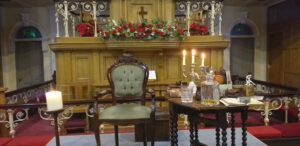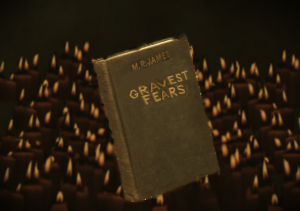For Ashville, Harrogate’s Wesley Centre has positive festive connotations. The venue hosts the annual carol service performed by Ashville and Elmfield Singers. For those who attended this year, the atmosphere proved cordial. But on Friday the 15th of December, I attended the Wesley Centre for a darker, more gripping and absolutely fantastic experience – the performance of ‘Gravest Fears’, a reading of two ghost stories based on the work of M.R. James.
Upon entering the Wesley Centre before the start time of 7:30, I was greeted by an admittedly rather bare room. The room, sporadically lit by the ceiling lights, was only adorned with festive decorations to a minor degree – they only appeared to be the decorations put up by the centre itself. Aside from the attendees – quite elderly in age, and boisterous in their unwrapping of buttermints – slowly coming in (greeted by a ticket collector, who kindly lent me some paper to make notes for this article) and the medieval church singing recordings – that were hard to make out, apart from words like ‘blood’ – there was really no visible indication that this was the reading of a ghost story. There was no indication of what type of performance this would be – and no sign of a narrator or host for the evening. This would be the case until (having moved further into the hall and taken the second row from the front on the left), a setup of a desk and green padded seat upon a small stage came into view. Edwardian in design, the paraphernalia on the desktop included: one lit candle; and candelabra (with three unlit candles); a half full brandy decanter (fake brandy, naturally for performance purposes) and accompanying glass; (and) a wide assortment of objects indicative of an academic nature scattered on the set (like a wooden box). Below is an image of the set:

This set would be the centre of the two 45-minute stories about to be told. As the clock struck half past the lights around the Wesley Centre were gradually turned off, immersing the whole room in darkness – aside from the single lit candle. The music went quiet, and a door opened at the back, revealing the imposing and tall figure of a man – the narrator, and our host for the evening. This silent, barely visible entrance proved to be quite hair-raising. The man made slowly and methodically for the stage, revealing a character dressed like the typical Oxbridge intellectual. He proceeded to prepare the stage for his first story: he lit the candelabra; poured himself a brandy; picked up the aforementioned wooden box; (and) sat down. He paused, then finally spoke – “It is with some reluctance… that tomorrow I must return this box to its rightful owner”. I. Was. Hooked.
Our host – a slightly rambling narrator styled on M. R. James himself – was played by Mr Robert Lloyd Parry. I was briefly able to speak to him after the performance, and to take the following picture with him:

Parry has a long connection to James, first portraying his works in 2005 – in James’ old study no less. Parry has performed over a variety of mediums – DVDs, Audiobooks, Guided Tours, and Live Readings. He has also portrayed James in Mark Gatiss’ documentary ‘M. R. James: Ghost Writer’ – although Parry only met Gatiss for one morning of the shoot, before Gatiss had to attend the Doctor Who Panel at San Diego Comic Con. His performance at the Wesley Centre was deeply akinned to the Gatiss’ essence (Mark Gatiss having produced his own adaptations of ghost stories from the likes of James and others for the BBC – with another one airing this year at 10pm, Christmas Eve on BBC 2). The entire act is a one man show. Parry had no assistants joining him on his performing tour, packing up shop himself after the performance (explaining the barebones and raw nature of the act). I was half-expecting a portrayal similar to that of the televised M.R. James adaptations read by Robert Powell from the 1980s – which can be found as part of the BFI’s ‘Ghost Stories for Christmas’ boxset (a highly recommendable boxset). Parry’s portrayal was much different. Powell went for the refined gentleman speaking King’s English in a style of giving a speech. Parry went for that slightly rambling Oxbridge professor, giving accents and mannerisms to each character discussed in an intimate and engaging lecture style – when one individual named ‘Old Martin’ was mentioned, our host quips “you know him of cause don’t you”. If you’re interested in finding out more about his work, you can do so on his website – https://www.nunkie.co.uk/ – which features some of his audiobooks, alongside a schedule for upcoming performances.
The two stories read were narratively similar: both set in a Cathedral (which the Wesley Centre greatly supported as a venue); both revolving around the accursed nature of their furnishings. The first story (‘The Stalls of Barchester Cathedral’) was admittedly more nuanced with more moving parts, but the second (‘An Episode in Cathedral History’) was still greatly enjoyable. The first regards the contents of the aforementioned box which discuss Barchester’s Archdeacon, Dr John Hayes. The contents include articles, letters, diaries, and (most ominously) Hayes’ obituary. Before delving in our host remarks, “I’m sure I can rely on your discretion, just as much as you can of mine”, before pausing to briefly tighten his eyelids and frown as if he heavily doubted the line – getting a laugh from the audience. The narrator discusses Hayes’ stress as he hears a voice addressing him. Between each source the narrator takes a swig of brandy. Parry portrays Hayes’ growing frustration masterfully with intensifying occurrences – “January 15th. It has happened again. How can it have happened again!” Parry becomes sterner for this line, raising his voice to echo around. The visits connect to carvings within Barchester’s stalls featuring Death, the Devil, and a cat. When once sitting in the stall, Hayes finds his hand “resting on the carved figure of a cat”, before being “startled by a feeling of softness”. A cat then stalks Hayes, and remains permanently stationed on his stairs – where Hayes is ultimately found dead, his faced savagely mauled. Our host mentions how a piece of the carving was later collected by a man who gave it to his children. They feared it so much the man burned it, ending on the peculiarity of destroying an apparently innocent figure – “it was only a cat!” With that, our host finished his brandy, picked up the box and its contents, and departed for the interval. Parry received a round of applause as he retreated backstage for the ten-minute interval with the return of the medieval singing and the lights. Discussions buzzed regarding the performance, and it hardly seemed like time had elapsed before the lights went down and our host returned – promptly pouring another brandy to slowly sip over the second story. The narrator recounts a tale he was told by the late Verger Werby of Southminster Cathedral (whom he presents with a distinct country accent and keen attitude to serve, as when the narrator goes to fetch his coat, Werby replies ‘got it here already’, to the audience’s amusement). Werby recounts a period of his adolescence, wherein a controversial refurbishment of Southminster Cathedral reveals a tomb under the pulpit – unmarked, with an uncoverable slit through which movement is noticed. This coincides with a period known as ‘The Crying’, wherein bloodcurdling cries are heard, and two glowing red eyes appear at night. Southminster’s Canons complain, one saying it was too much like ‘Isiah 34:14’ – “the satyr shall cry to its fellow”. This culminates in the dean, the canons and Werby’s father attempting to enter the tomb, only for panic to emerge when: the dean is thrown to the floor; the canons scramble; (and) Werby’s father sees something. Parry again brilliantly captures stress and fear, this time of Werby Senior as he addresses young Werby – “Didn’t you see it?! A thing like a man?! Hair all over him?! And two great eyes to it?!” – and the story ends with the narrator reading the inscription that was written on the tomb. “Ibi Cubavit Lamia” – “There sleeps the Night Hag”. And with that, our host finishes his brandy, stands hands behind his back, and takes his bow – to the audience’s ecstatic applause.
Parry once again retreated backstage, the lights fully came up, and the audience slowly departed – leaving behind their buttermint wrappers. I went to take a photo of the set, when Parry re-emerged – now out of costume. It was now time for his busy job of packing up for the night, before performing the show again the following evening, and then moving onto the next part of his tour. I went into ‘Gravest Fears’ not entirely sure on what was going to happen. This was not a flashy performance with an extravagant set and someone in the audience popping out at the end as a ghost, and neither was it a formal and distant performance. Barebones and intimate, this one-man extravaganza proved frighteningly fantastic, providing a real sense of fear – not the jump-scare type of fear, but a subtler and longer-lasting fear – and Parry himself performed the whole show admirably with eloquence – even though he admitted afterwards that he slightly flubbed a few of his lines. ‘Gravest Fears’ was an inspired and radiant performance, sensationally brought to life single-handedly by Robert Lloyd Parry. Parry’s performances will resume in February of 2024, and I highly recommend that you try and catch some of his work in the future.

